Was Charles Taze Russell an Freemason?
Almost everyone who has researched Jehovah's Witnesses online has at one point come across the statement that Charles Taze Russell was a Freemason. Some websites even state that he was a 33rd degree Mason, that he was part of the Illuminati, that he is a reptilian, etc.
Most of these statements originated from a book written by Fritz Springmeier called The Watchtower and the Masons: A Preliminary Investigation. It can be found here.
Do the facts show that he was really a Freemason?
This article has the following parts:
- How Freemasons are Generally Recognized
- What Historians of Jehovah's Witnesses Say
- What Freemasons Themselves Say
- Famous Freemasons
- "Proofs" Disproven
How Freemasons are Generally Recognized
According to the Wikipedia article "List of Freemasons (A-D)", this is how one would know if someone was a Freemason:
"Standards of "proof" for those on this list may vary widely; some figures with no verified lodge affiliation are claimed as Masons if reliable sources give anecdotal evidence suggesting they were familiar with the "secret" signs and passes, but other figures are rejected over technical questions of regularity in the lodge that initiated them. Where available, specific lodge membership information is provided; where serious questions of verification have been noted by other sources, this is also indicated."
In other words, the easiest way to know if someone was a Mason is by searching in the association lists of the Lodges. In other occasions, one can know if someone was a Mason by means of their knowledge of the signals and secret passes. In both things, the evidence shows that Russell was not a Mason. This is said many times over by historians of Jehovah's Witnesses.
What Historians of Jehovah's Witnesses Say
Most JW historians (including exJW's such as James Penton, Barbara Anderson, and Lloyd Evans) say that Russell was not a Freemason. They say this with good reason.
James Penton
In his book Apocalypse Delayed: The Story of Jehovah's Witnesses, Third Edition, on pages 64 and 415, he said this as to whether Russell was a Mason or not (emphasis ours):
Yet over the years critics of Russell and Jehovah's Witnesses have continued to use Ross's fallacious statement plus a number of other charges, two of which should be regarded as utter nonsense. The first is that Russell was into occult practices, and the second is that he was a Freemason. [127] The first claim is based almost entirely on his use of certain symbols such as the winged disk that appeared on copies of Studies in the Scriptures and the cross and crown motif that appeared in Watch Tower literature and was often worn by Bible Students as religious ornaments. But instead of being drawn from Egyptian paganism as has been asserted by Russell's adversaries, the winged disks simply represented "the sun of righteousness" that would "arise with healing in his wings" according to Malachi 4: 2. As for the cross and crown motif, it was simply a common one in the nineteenth and earlier centuries that was used by many Christian groups. Equally specious is the claim that Russell was a Freemason. That is easy to see from comments in which he advised Bible Students against becoming Masons [128] and by his lack of knowledge of the work and rituals of Freemasonry. " 127 For a prime example of such claims, see Fritz Springmeier, The Watchtower and the Masons (Portland, Oregon: printed privately, 1990). 128 He stated: "We note also the Order of Free Masons, if judged by its past history, has some secret object or scheme, more than fraternity and financial aid in time of sickness or death. And, so far as we can judge, there is a certain amount of profane worship or mummery connected with the rites of this order and some others, which members do not comprehend, but which, in many cases, serves to satisfy the cravings of the natural mind for worship, and thus hinders it from seeking the worship of God in spirit and truth - through Christ, the only appointed Mediator and Grand Master" (WT, reprints 1827).
Lloyd Evans
In his book The Reluctant Apostate: Leaving Jehovah's Witnesses Comes at a Price, Lloyd Evans also mentions the subject on the Kindle Locations 12139-12142:
Some attribute Russell's fascination with pyramidology, as well as his use of certain symbols of Masonic origin, as evidence that he was a Freemason. In the absence of definitive proof to support this claim, and with the Freemasons denying that Russell was a member, I choose not to give it too much credence.
Bruce W. Schulz y R. M. de Vienne
In their book A Separate Identity: Organizational Identity Among Readers of Zion's Watch Tower: 1870-1887, by B.W. Schulz and R. M. de Vienne, they say on page 340 (emphasis and brackets ours):
Without doubt Russell associated with some who were Masons. His uncle [Thomas Birney] was a Mason. Some of his earliest associates were, and some of his known business associates were Masons. Does this imply that Russell was one? The authors of this book teach. We associate on a regular basis with children. But, hopefully, we have passed beyond childhood. Associations do not indicate membership in a group. Find a membership list with Russell's name on it. That would be good, solid evidence. Present that to us, and we'll revise this book; otherwise, stop being stupid. Russell made a few comments on Masons. These are taken out of context; occasionally the quotation is altered. Russell's comments reflect an outsider's view of the Masonic brotherhood. The quotation seen in context has Russell say that he was never a Mason. Absent real evidence that he was a Mason, one must reject this claim. Even if we could readily find his name on a lodge membership list, we would be left with proving a grand Masonic conspiracy. That is the stuff of second-rate adventure movies, not history. 1 am bringing this distasteful task to an end. Certainly some who read this book will not release their grasp on a conspiracy theory that gives them some sense of self-justification or of possessing esoteric knowledge, but the membership lists of the Pittsburgh and Allegheny Lodges are easy to find. Show us his name on one of those lists.
The same book provides proof that Thomas Birney, Russell's maternal uncle, was a Mason, on pages 3 and in their footnotes:
Thomas was a member of St. John Lodge of Free and Accepted Masons. We cannot find a membership for Joseph.14 14 Death of Thomas Birney, Pittsburgh, Pennsylvania, Press, January 17, 1899. The obituary misnames his partner as James R. Woodwell. The membership list for St. John's Lodge is found in An Address Delivered at the Request of St. John's Lodge, no. 219, F. & A.M. at the 444th Stated Meeting, April 12th, 1883, on the History of the Lodge, and the Establishment of Freemasonry in Pittsburgh. Thomas Birney's name appears in the membership list on page 112. No Russells find a place on the list, nor do they receive other mention. For details see Appendix One.
Barbara Anderson
Turns out that Barbara Anderson did the investigation that B.W. Schulz and R.M. de Vienne suggest, that is, checking in the membership lists of the Masonic Lodges where Russell lived. On her website, Watchtower Documents, she writes:
C. T. Russell Was Never a Freemason Back in 2001, I requested historical information from the ANCIENT ACCEPTED SCOTTISH RITE OF FREEMASONRY, VALLEY OF PITTSBURGH, PENNSYLVANIA, asking if Charles Taze Russell, his father, Joseph Lytel Russell, and his uncle, Charles Tays Russell, were Pennsylvania Freemasons. This is the answer I received in a letter: "AFTER A SEARCH OF OUR RECORDS, WE DETERMINED THAT THE THREE RUSSELLS WERE NOT MEMBERS OF OUR ORGANIZATION." In their letter, the Pittsburgh Chapter recommended that I send an inquiry asking for further research into this question to the Grand Lodge of Pennsylvania located in Philadelphia - which I did. On April 27, 2001, I received this reply: "THE RECORD BOOKS IN THE GRAND SECRETARY'S OFFICE ARE UNAVAILABLE AT THIS TIME AS THEY ARE BEING CONSERVED AND SHOULD BE BACK SOME TIME IN THE FALL." Inasmuch as I was very involved with other, more pressing things then, I did not follow-up and eventually my desire for resolution of this question faded out of my mind, that is, until September 2005 when I sent a follow-up email to the Masonic Temple, Grand Lodge of Pennsylvania in Philadelphia. Shortly thereafter, I received this reply: DEAR MS. ANDERSON, CHARLES TAZE RUSSELL WAS NOT A PENNSYLVANIA FREEMASON. NOR DOES HE APPEAR IN THE RECORDS OF ENGLAND OR IRELAND. I SHALL CHECK THE RECORDS FOR THE OTHER TWO RUSSELLS. BEST, GLENYS A. WALDMAN LIBRARIAN I never checked back with Ms. Waldman to see whether the other two Russell's were Pennsylvania Freemasons, but there has never been any evidence they were, so I didn't bother. In any event, I would hope the answer from a search of the original records will forever put this claim to rest that Charles Taze Russell was a Pennsylvania Freemason because he absolutely was not.
What Freemasons Themselves Say
At least two websites about Masons say that Russell was not one:
Grand Lodge of British Columbia and Yukon
The Grand Lodge of British Columbia and says in their website:
The Grand Lodge of Pennsylvania, The Grand Lodge of Ireland, and the United Grand Lodge of England have no record of his membership... [Charles Taze Russell was a] Non-Mason.
Masonic Info
A website called Masonic Info, which provides general information to the public about Masons, says in their webpage that discusses famous non-Masons:
There is no credible evidence whatsoever that Charles Taze Russell, the founder of the Jehovah's Witness faith, was a Mason... In the final analysis, those attempting to condemn Russell based on supposed Masonic membership fail to produce any evidence of his membership (the name of his lodge or the names of lodges he ostensibly visited, for example) ... Russell is not mentioned in any Masonic reference works, a unique situation indeed if he were a Mason, if only because of his notoriety.
Famous Freemasons
There are many well known and famous Freemasons. Unlike Russell, for them, there is abundant proof that they were Freemasons.
At least two well known religious leaders were Freemasons: William Miller (who was the "father" of the Adventist Movement), and Joseph Smith, who founded the Church of Jesus Christ of Latter Day Saints, otherwise known as the Mormons.
William Miller
There are many proofs that Miller was a Mason. He was initiated in the Morning Star Lodge #27, and the book God's Strange Work: William Miller and the End of the World, by David L. Rowe, has extensively documented Miller's association with Freemasonry.
Joseph Smith
There are also lots of proofs that Joseph Smith (founder of the Mormons) was a Freemason. In fact, he started a new Lodge!
In the book History of the Church, Volume 4, pp. 550-551, Joseph Smith wrote:



Famous Masons who were not Religious Leaders
There are other famous Freemasons who were not religious leaders. At least 14 (some would say 15) U.S. Presidents have been Freemasons.
There probably isn't an individual picture in Masonic Regalia for every President of the United States, but this picture has them all:
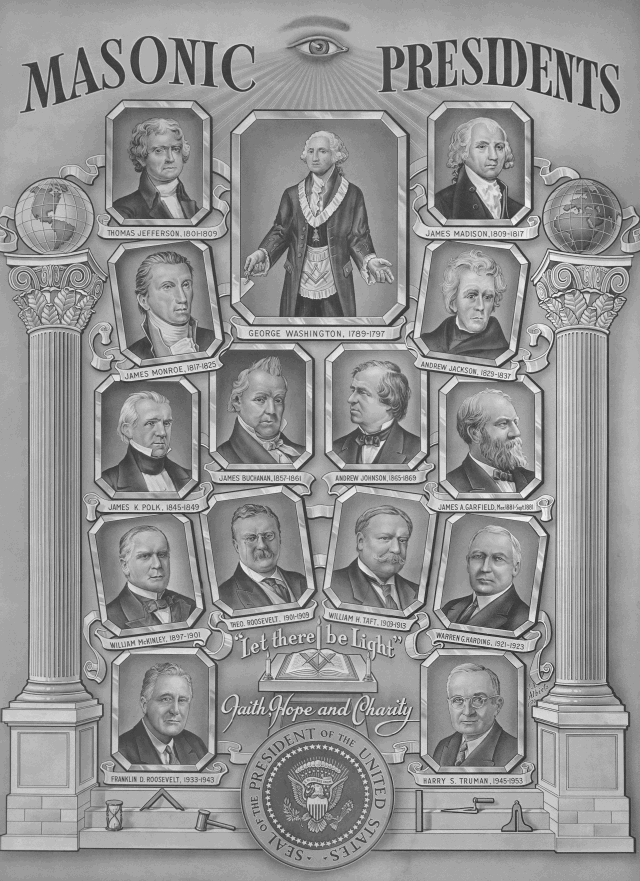
This website has abundant information regarding each President's relationship with Freemasonry.
Considering them individually:
George Washington
For example, for George Washington, the following proofs exist: There is this painting which is a portrait of George Washington in Masonic Regalia:
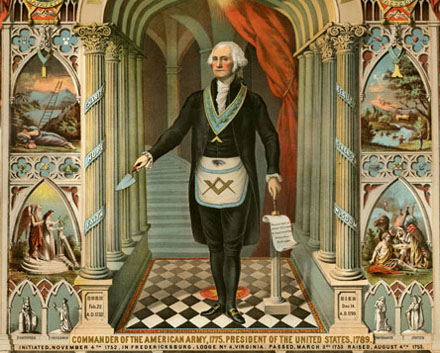
There's even an entire museum dedicated to the fact that he was a Freemason. You can visit the museum's website here.
George Washington was initiated on November 4, 1752 in Fredericksburgh Lodge No. 4, Fredericksburg, Virginia. Elected Worshipful Master on December 20, 1788.
James Monroe
Freemasons know that James Monroe was one. There is, for example, this commemorative stamp:
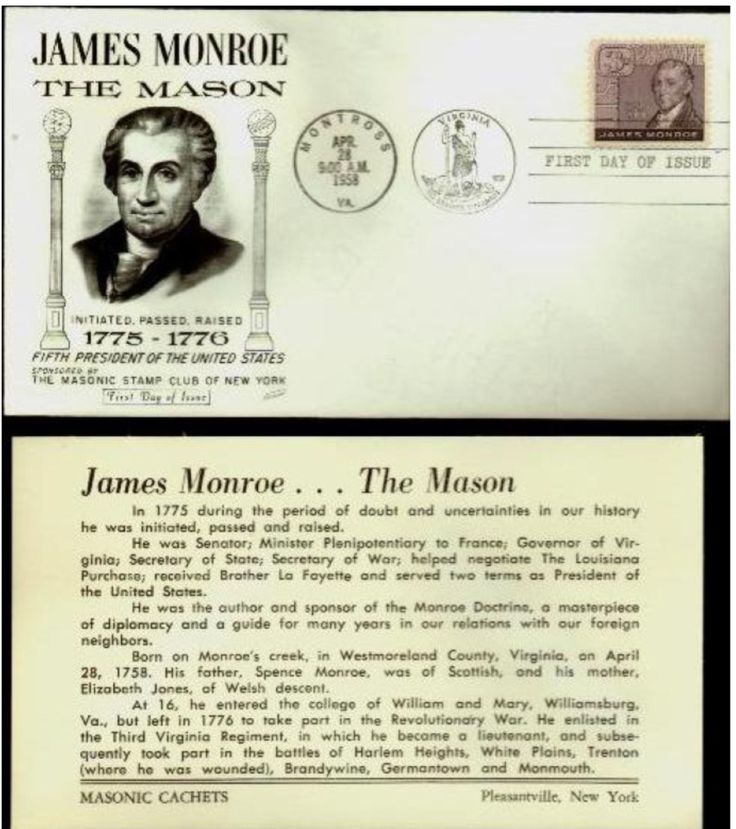
This website has more information. James Monroe was initiated on November 9, 1775 in Williamsburg Lodge No. 6, Williamsburg, Virginia at the age of 17 while he studied at the College of William & Mary.
Andrew Jackson
Andrew Jackson has this portrait in Masonic Regalia:
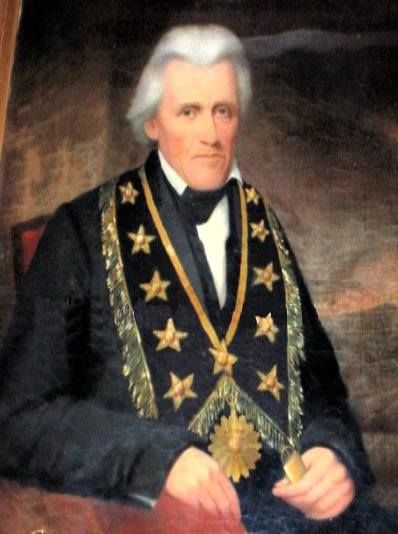
His tombstone also mentions he was a Freemason:
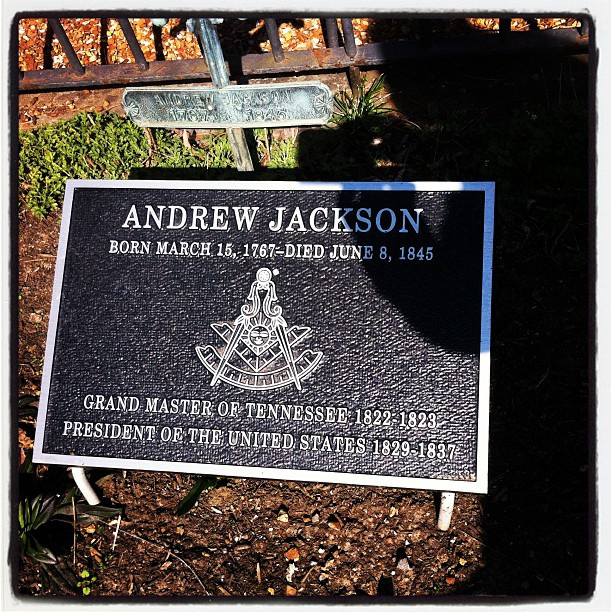
He was a member of St. Tammany (later Harmony) Lodge No. 1, Nashville, Tennessee. Elected Grand Master of Tennessee on October 7, 1822 and served until 1823 or 1824 (Different sources conflict on this). This website has more information.
James K. Polk
No picture of James K. Polk with Masonic Regalia could be found, but it is known that he was initiated on June 5, 1820 in Columbia Lodge No. 31, Columbia, Tennessee. This website has more information.
James Buchanan
No picture of James Buchanan with Masonic Regalia could be found, but it is known that he was initiated on December 1, 1816 in Lodge No. 43, Lancaster, Pennsylvania. Appointed District Deputy Grand Master for the Counties of Lancaster, Lebanon and York in 1824. This website has more information.
Andrew Johnson
No picture of Andrew Johnson with Masonic Regalia could be found, but it is known that he was initiated on May 5, 1851 in Greenville Lodge No. 119, Greenville, Tennessee. This website has more information.
James A. Garfield
No picture of James A. Garfield with Masonic Regalia could be found, but it is known that he was initiated on November 19, 1861 in Magnolia Lodge No. 20, Columbus, Ohio and raised on November 22, 1864 in Columbus Lodge No. 30. Joined Garrettsville Lodge No. 246, Garrettsville, Ohio in 1866 and was its Chaplain for the years 1868-69. Charter Member of Pentalpha Lodge No. 23, Washington, D.C. This website has more information.
William McKinley
There is this portrait of William McKinley with Masonic Regalia:
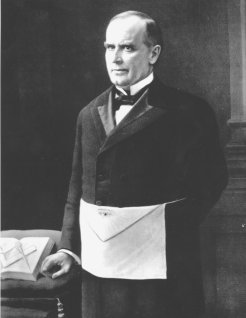
It is also known that he was initiated on May 1, 1865 in Hiram Lodge No. 21, Winchester, Virginia. Joined Canton Lodge No. 60, Canton, Ohio in 1867. Charter member of Eagle (later William McKinley) Lodge No. 431, also in Canton. This website has more information.
Theodore Roosevelt
There is this portrait of Theodore Roosevelt with Masonic Regalia:
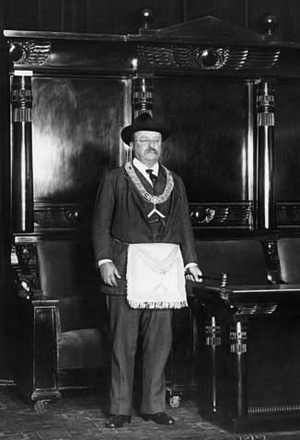
It is also known that he was initiated on January 2, 1901 in Matinecock Lodge No. 806, Oyster Bay, New York. This website has more information.
William Howard Taft
There is this portrait of William Howard Taft with Masonic Regalia:
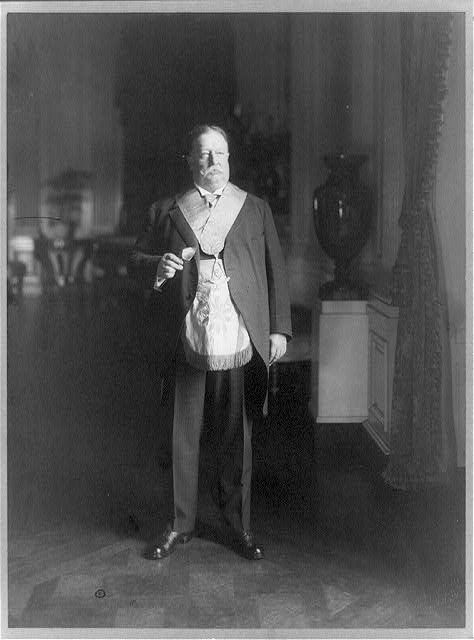
It is also known that he was made a Mason at Sight on February 18, 1909 in Kilwinning Lodge No. 356, Cincinnati, Ohio. This website has more information.
Warren G. Harding
There is this portrait of Warren G. Harding with Masonic Regalia:
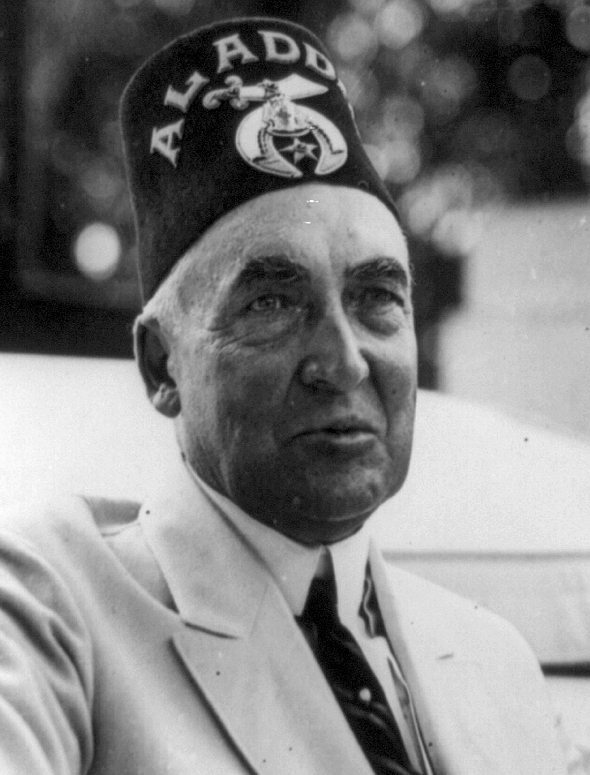
It is also known that he was initiated on June 28, 1901 in Marion Lodge No. 70, Marion, Ohio. Raised on August 27, 1920 in that Lodge. This website has more information.
Franklin D. Roosevelt
There is this portrait of Franklin D. Roosevelt with Masonic Regalia (he's in the center):
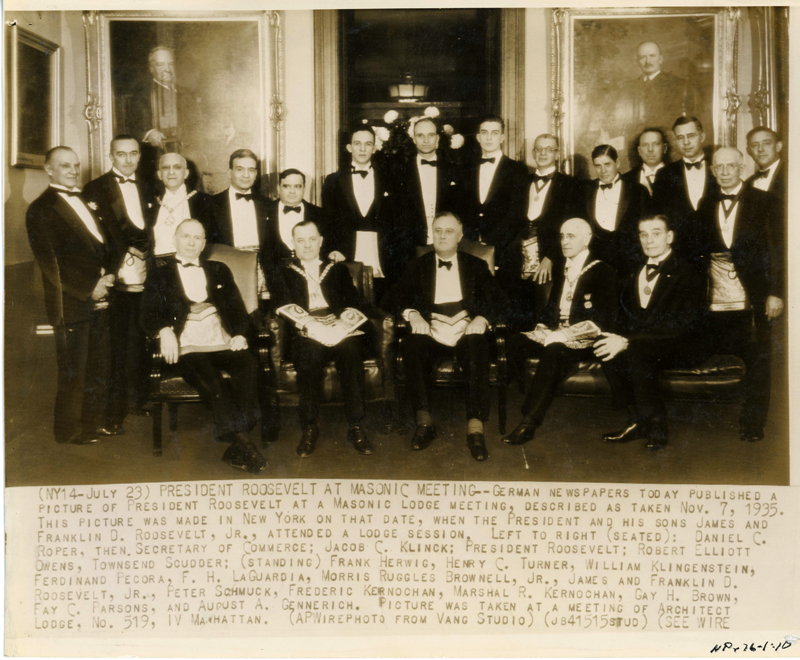
It is also known that he was initiated on October 11, 1911 in Holland Lodge No. 8, New York City. Made Honorary Grand Master of the Order of DeMolay on April 13, 1934. This website has more information.
Harry S. Truman
There is this portrait of Harry S. Truman with Masonic Regalia:
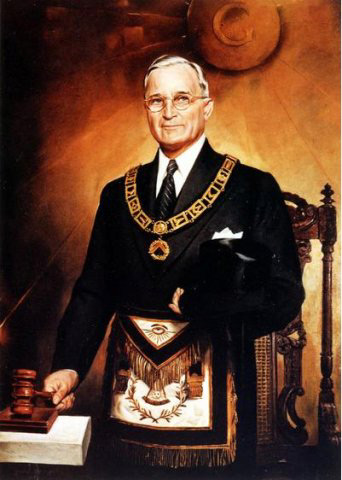
It is also known that he was initiated on February 9, 1909 in Belton Lodge No. 450, Belton, Missouri. First Worshipful Master of Grandview Lodge No. 618, Grandview, Missouri in 1911. Elected Grand Master of Missouri on September 25, 1940 and served until October 1, 1941. Received the 33rd Degree on October 19, 1945. Made Honorary Grand Master of the Order of DeMolay on May 18, 1959. This website has more information.
Gerald Ford
There is this portrait of Gerald Ford with Masonic Regalia:
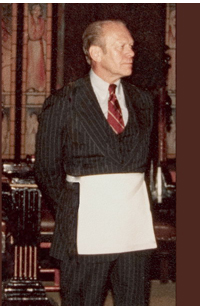
It is also known that he was initiated on September 30, 1949 in Malta Lodge No. 465, Grand Rapids, Michigan. Passed on April 20, 1951 and raised on May 18 of that year in Columbia Lodge No. 3, Washington, D.C. Received the 33rd Degree on September 26, 1962. Made Honorary Grand Master of the Order of DeMolay in April 1975. This website has more information.
"Proofs" Disproven
As "proof" that he was a Freemason, the following statements are generally made:
- He used multiple Masonic Symbols in his publications
- He is buried under a pyramid, which is a Masonic Symbol
- He is buried on or near a Masonic Temple/Center
- He gave a speech in which he mentioned he was a Mason
- The Masons have made a conspiracy to remove his name from the registry because they're ashamed of him.
The Masonic Symbols
While it's true that Russell and the Bible Students used (and modern Witnesses still use some) the following symbols,
- The Pyramid of Giza
- The Winged Sun Disk
- The Cross and Crown
- The Watch Tower
- Two Pillars
- The All Seeing Eye
- The Pleiades
- YHWH
These symbols are used by Freemasonry, and given that there are so many Masonic Symbols used in so many publications, many reach the conclusion that Russell was a Mason. But the usage of symbols alone does not mean that one is a member of a certain organization. These symbols are not exclusive, neither did they originate, from Freemasonry. Also, the reasons given as to why they were there in the first place do not have to do with Freemasonry.
The reasons for the first three symbols are known. The Pyramid: Russell got Adventist ideas, many of them were obsessed with the Pyramid, and so was Charles Piazzi Smyth, who influenced Russell The Winged Solar Disk: Russell thought that this symbol had to do with Malachi 4:2,
In the New World Translation, 1984 version, it says:
And to YOU who are in fear of my name the sun of righteousness will certainly shine forth, with healing in its wings; and YOU will actually go forth and paw the ground like fattened calves.
The Cross and Crown: It's a symbol used by various religions, including many Catholic Churches. It can be considered a Christian symbol, that implies sacrifice (the Cross) and reward (the Crown).
What is the conclusion that can be reached?
The Russell plagiarized many things from many sources, and that he introduced to a supposedly "pure" religion many pagan things (such as the pyramid, which cna hardly be considered a Christian symbol). These symbols were used for a long time after 1919, when the Witnesses state that Jesus came and examined all religions, and chose the Witnesses for being "clean".
However, the use of symbols alone do not prove that Russell was a Freemason. For more information, see the article Da Vinci Code.
He is Buried Beneath a Pyramid
He is buried in a regular grave. Near his grave, a pyramid-shaped monument was built. It was built by the Watchtower Society in 1919, more than 2 years after his death, because he admired the pyramid.
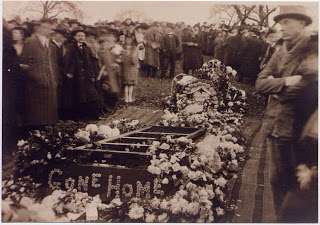
The picture above shows Russell's funeral. As you can see, there is a simple headstone. There is no pyramid. Russell died on October 31, 1916. His followers, in 1919, made the pyramid-shaped monument close to his grave. In the I.B.S.A. Convention Report for 1919, there's a report of Russell's followers going to his grave, and that, still in January 1919, plans were being made to make the monument. You can see the picture below, which comes from that convention report:
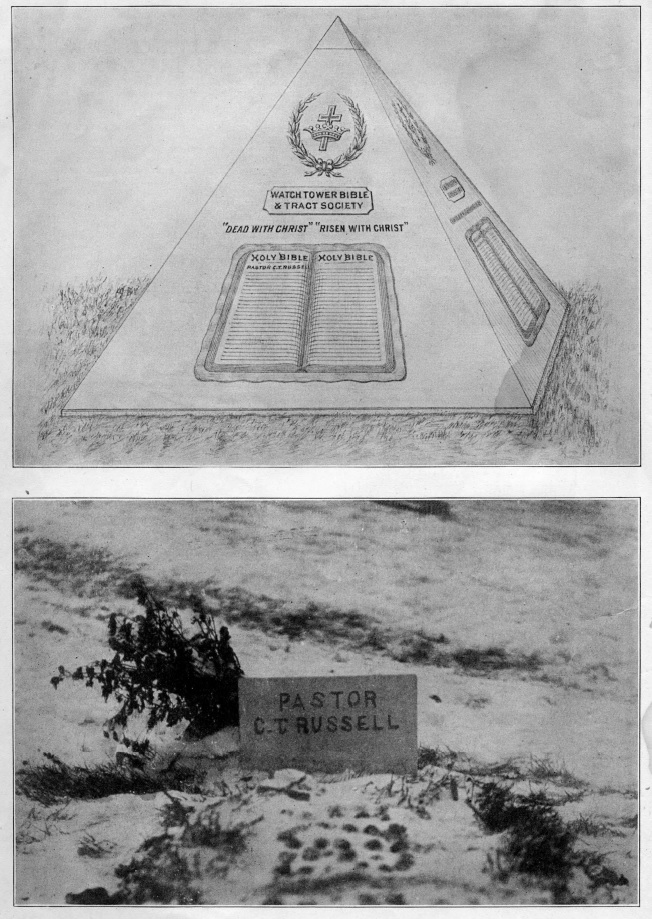
The report says the following about the tomb visit:
AT THE GRAVE On Monday, a party of about 150 was conducted by Brother Bohnet to the grave of Brother Russell. Upon a hillside, sloping towards,the south, we joined hands around the grave and sang... One last lingering look upon the scene recalled the peaceful manner of our Pastor's "passing beyond the vail." Brother Rutherford's words came to mind: "I am glad this prison experience was reserved for us, rather than for our dear Brother Russell." We visited the marble works and there watched the workmen slowly but surely chisel out the monument to be erected as a memorial to the Society. The Watch Tower Society burial lots in Rosemont United Cemeteries, five miles due north of Pittsburgh City, contain ample grave space for all the members of the Bethel family, and the Pilgrims and their wives-in all more than 275 adult graves. In the exact center of the Bethel lot will be erected diagonally the Pyramid Shape Monument as designed by Brother Bohnet, and accepted by Brother Russell as the most fitting emblem for an enduring monument on the Society's burial space. The size of this structure is nine feet across the base, and its apex stone is exactly seven feet above the ground surface level. It rests upon a concrete foundation five feet deep and heavily reinforced with barbed wire, the work of Brother Bohnet, who would not entrust this important task to anyone else, so we are assured the job was well done. The brother. gave a full description of the securing of the rock material (after fruitless attempts extending over a period of about five years) at the time he piloted the conventionists to the cemetery and urged us to help ourselves to souvenir chips in the shop of the granite worker near by. These monster blocks of pink (Brother Russell's favor-ite tint) i granite were brought all the way from Granite Mountain Quarries, near Marble Falls City in Texas, upon a special flat car, and are said to be about 95 per cent flint rock. Each slope of the pyramid will face one of the large lots and on each of these slopes is cut in four-inch embossment a Teacher's Bible, on the pages of which will appear the names of the ones buried there. The burial space for Brother Rutherford was indicated and his name, like that of Brother Russell, will be at the top of opposite Bible pages. A Bible space being set apart for the Pilgrims -all in one lot of forty-eight grave space, so all their names will appear on the same Bible. Above the Bibles are spaces for inscriptions in full, W. T. B. & T. S., I. B. S. A., "Dead with Christ," "Risen with Christ," etc. And above these the Cross and Crown and Wreath, and the whole capped with the apex stone, highly polished-its shape of course being pyramidal. Within the structure, incased in a block of granite, will be a sealed metal box in which is a complete set of Karatol Scripture Studies, the. Memorial Tower, and one of every tract, photographs of Pastor Russell, a copy of the Society's charter, and many other things to interest the people who at some future date may open the pyramid and find them. Brother Wm. B. Hurst, of Pittsburgh, who was assist-ant superintendent of the United Cemeteries under Brother Bohnet's general charge, will have the care of Brother Rus-sel's grave in the pilgrimage absence of Brother Bohnet. It is expected the monument will be in place before the next Decoration Day. Any truth people desiring a chip of the stone may send postage enough to carry a piece about the size of an egg, with enough additional to pay the Society for the trouble of having it wrapped for the mail. Best for class members to order collectively.
Below, you can see a modern picture of Russell's grave:
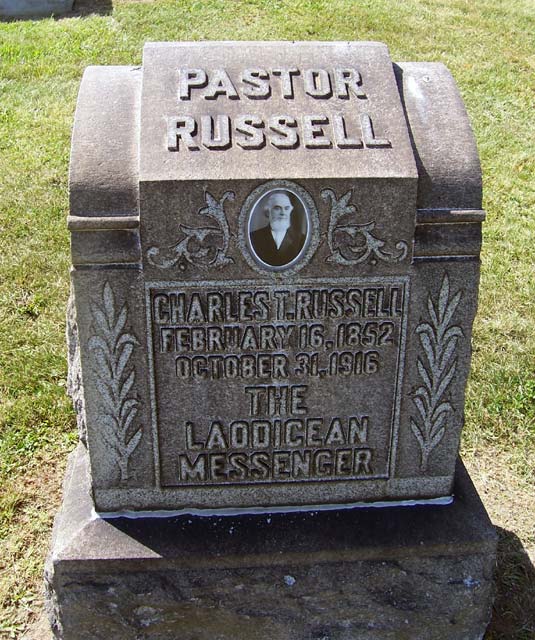
As you can see, his tomb is not a pyramid, but a regular one. There are no Masonic symbols in his headstone. The following images of the area close to the grave show how his grave is located in one place, and the pyramid is close by:
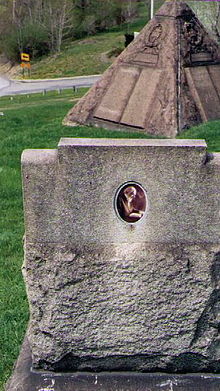
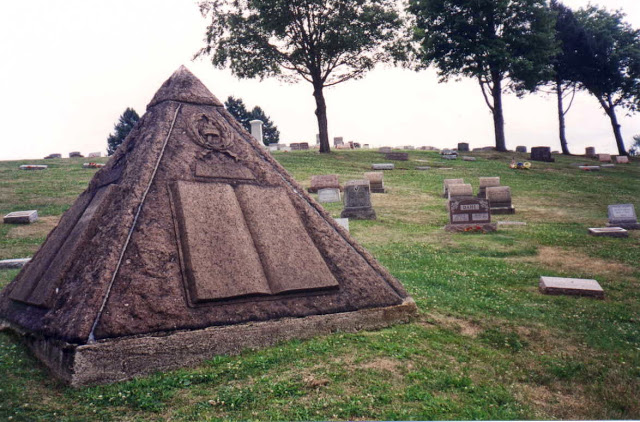
He Is Buried In or Near a Masonic Temple
The pictures above clearly showed that he's not buried in a Masonic Temple. There is, however, a Masonic Center near Russell's cemetery. But it was not built there to honor Russell, nor was it there for nearly 80 years after Russell's death. The Greater Pittsburgh Masonic Center was built in 1996, and the reasons for building it where it is had nothing to do with Russell. Unfortunately, it does make it harder to convince someone that Russell was not a Mason. The following pictures show how Russell's grave, the Pyramid Monument, and the Greater Pittsburgh Masonic Center are in relation to each other:
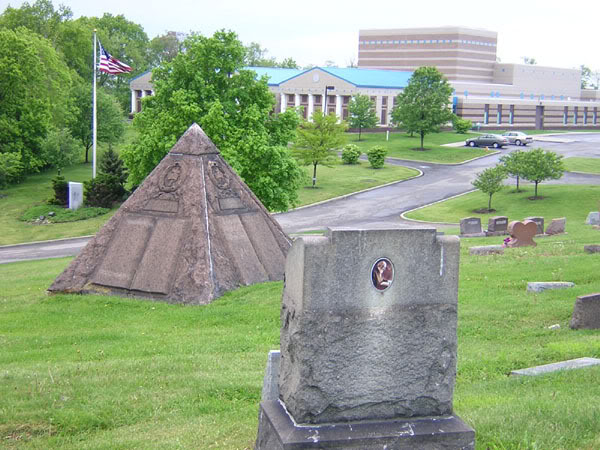
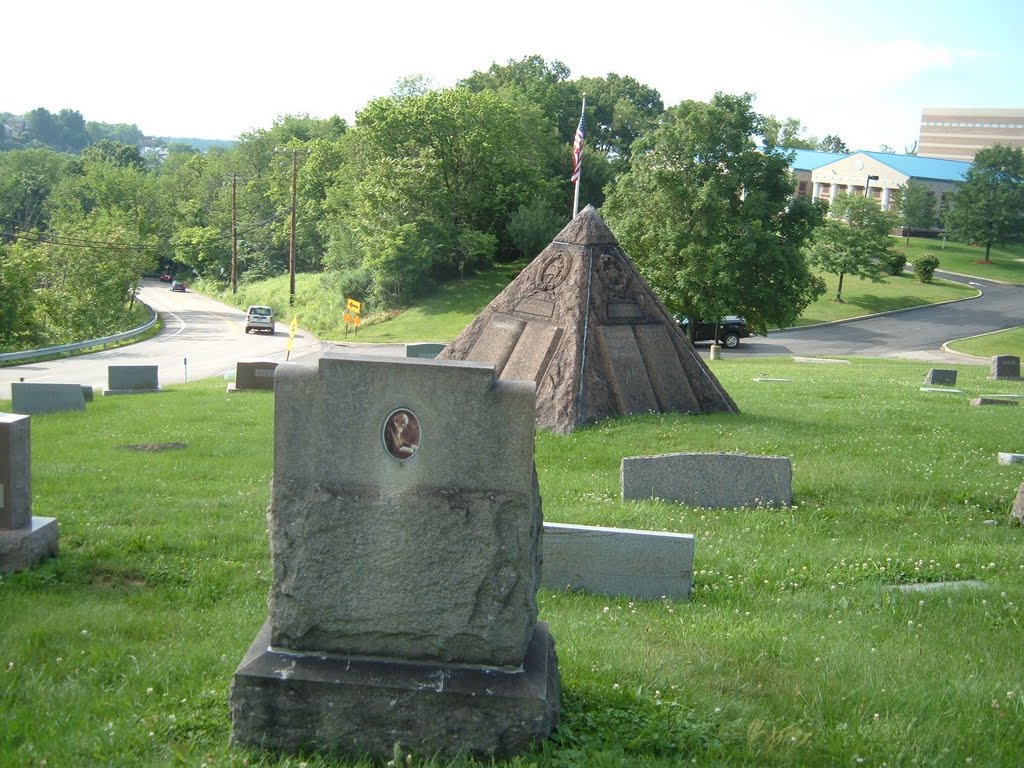
It's easy to conclude that the Masonic Center was built there to honor Russell. But it was merely a coincidence, the Rosemont United Cemetery and the previous owner of the field where the Greater Pittsburgh Masonic Center are located, the Catholic Diocese of Pittsburgh, are two different entities. Besides, the Masonic Center was not built until 1996. The pictures below, both at ground level and satellite, show that the Masonic Center was not in existence before 1996 (the first picture is from 1991):
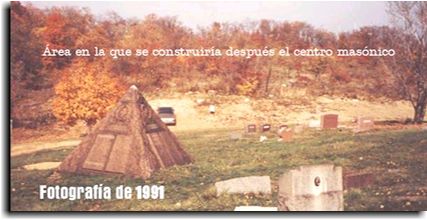
Satellite images comparing the area between 1993 and 2015 (click on the thumbnail to see the picture in higher resolution):

Pre-1996, Pittsburgh Masons met in the Pittsburgh Masonic Temple, located at 4227 Fifth Ave, Pittsburgh, PA 15260, USA. The building was sold in 1993 to the University of Pittsburgh. You can see the newspaper report of the salehere. Also, this Masonic magazine, of August, 1996, on pages 6 and 7, mentions the construction of the Greater Pittsburgh Masonic Center. Notice the reasons given for the location:
The final touches are being made to the new Greater Pittsburgh Masonic Center in preparation for a grand opening... The former Masonic Temple, located in the Oakland section of Pittsburgh, was completed in 1915. In recent years, rising costs of operating the building, primarily because of real estate taxes, necessitated the raising of assessments on the bodies meeting in the old building. This, in turn, resulted in bodies finding other meeting locations. In 1993, the University of Pittsburgh approched the Masonic Temple Trustees, who held title to the property... negotiations culmina[ted] in the purchase of the Temple by the University on Dec. 23, 1993. for a price of $8.6 million. The University agreed to allow the Masons to continue occupancy until December 1995, to afford time for the erection of a new facility. The date was later extended to May, 1996... Primarily because of tax considerations, the group investigated properties outside the city limits. They found that a 42-acre plot of land was available for purchase from the Catholic Diocese of Pittsburgh. On April 5, 1994, the Board voted to purchase the property, located on Cemetery Lane in Ross Township. Groundbreaking too place on September 21, 1994... The cornerstone was laid in an impressive ceremony conducted by the Grand Lodge of Pennsylvania on October 9, 1995.
Gave a Speech Where He Said He Was a Freemason
Russell gave speeches in many places. In 1913, in a speaking tour, he gave a speech in a Masonic Temple to an audience that obviously included many Freemasons. It is not necessary for one to be a Mason to either enter into a Masonic Temple or use the facilities for events. For example, I have entered into a Masonic Temple, and seen all of the symbols used. The Greater Pittsburgh Masonic Temple has a part of its website dedicated to having events, such as weddings, in the Center. The speech can be found in its entirety here, starting on page 914.
This speech, when one reads it carefully, in its full context, shows that Russell was trying to use what he knew about Freemasonry to try and make parallells between them and his religion, between them and his interpretation of the Bible.
This was not unlike the Apostle Paul, who said in 1 Corinthians 9:19-23:
For, though I am free from all persons, I have made myself the slave to all, that I may gain the most persons. 20 And so to the Jews I became as a Jew, that I might gain Jews; to those under law I became as under law, though I myself am not under law, that I might gain those under law. 21 To those without law I became as without law, although I am not without law toward God but under law toward Christ, that I might gain those without law. 22 To the weak I became weak, that I might gain the weak. I have become all things to people of all sorts, that I might by all means save some. 23 But I do all things for the sake of the good news, that I may become a sharer of it with [others].
Russell clearly was trying to "make himself a Mason to win over Masons". But he showed he knew little about Freemasonry.
For example, in this part of the speech, Russell called the Masons a "denomination". They're not a religion, any Mason (or anyone who reads what is known to the public about them) would know this. He said:
As Christian people, Bible Students from all denominations, it would seem that we have something in our faith that is in sympathy and harmony with each denomination, the world over. Do our Presbyterian friends speak of the election? We more. Do our Methodist friends have the doctrine of free grace? We more. ... Do our Masonic friends understand something about the Temple, and being Knights Templars, and so on? We more...
In Freemasonry FAQ pages, it is said:
Freemasonry is not a religion, nor is it a substitute for religion. It requires of its members a belief in God as part of the obligation of every responsible adult, but advocates no sectarian faith or practice. Masonic ceremonies include prayers, both traditional and extempore, to reaffirm each individual's dependence on God and to seek divine guidance. Freemasonry is open to men of any faith, but religion may not be discussed at Masonic meetings.
The speech continues:
I am very glad to have this particular opportunity of saying a word about some of the things in which we agree with our Masonic friends, because we are speaking in a building dedicated to Masonry, and we also are Masons. I am a Free Mason. I am a free and accepted Mason, if I may carry the matter to its full length, because that is what our Masonic brethren like to tell us, that they are free and accepted Masons. That is their style of putting it. Now I am a free and accepted Mason. I trust we all are. But not just after the style of our Masonic brethren. We have no quarrel with them. I am not going to say a word against Free Masons. In fact, some of my very dear friends are Masons, and I can appreciate that there are certain very precious truths that are held in part by our Masonic friends. I have talked to them at times, and they have said, How do you know about all of these things? We thought nobody knew anything about these things except those who had access to our very highest logic. I said that I had been in conference with the Great Master Workman, the Lord himself, and I have secret information through the Holy Spirit and guidance in respect to what the Bible says, and that contains all the truth, I believe, on every subject. And so if we talk to our Masonic friends about the Temple and its meaning, and about being good Masons, and about the Great Pyramid, which is the very emblem they use, and what the Great Pyramid signifies, our Masonic friends are astonished. One who had been a Mason a long time recently bought a lot of books that had the Great Pyramid discussed, and sent them to I am sure a thousand Masons. He paid for them and sent them out at his own expense. He wanted the Masons to see something about the Great Pyramid. He knew they were greatly interested in that. But we are not going to discuss the Great Pyramid this afternoon. We are going to discuss free and accepted Masonry-- the Bible Masonry, my dear friends.
The vast majority of the sources that claim that Russell was a Freemason only quote the part where he says "I am a Free Mason". But only a few paragraphs later, with some more context, he says that he is not a Mason, and it becaomes clear that he was making analogies.
Those who want to "probe" that Russell was a Mason generally don't quote this section:
Now the question arises, How can we become members of this order? Would you like to become one of these Knights Templar on the heavenly plane. I am not saying anything against the earthly Knights Templar. You can use your own judgment... If you think it is the will of God you should join the Odd Fellows, and don't feel you are Odd Fellow enough in becoming a follower of the Lord, go and join the Odd Fellows. If you feel that you want to become a member of the Free and Accepted Order of Masonry, and do not feel free and Masonic enough as a follower of Christ, God bless you, use your judgment; that is yours to decide, not mine.... Although I have never been a Mason,, I have heard that in Masonry they have something which very closely illustrates all of this... I have often wondered where they found out so many of the secrets of our High and Accepted Order of Masonry.... More than that, our Masonic friends have great trouble in keeping their secrets from leaking out, but God in his great Secret Society has fixed it so that you can tell all you like about it, and the other man cannot understand it unless he has the key.... So, then, I repeat what Jesus said about the terms of membership. I do not know if we are all members of this order or not. You know our order is so secret we cannot know each other always. Is not that wonderful? I find that is so with Masons also. Many Masons shake hands with me and give me what I know is their grip; they don't know me from a Mason. Something I do seems to be the same as Masons do, I don't know what it is; but they often give me all kinds of grips and I give them back, then I tell them I don't know anything about it except just a few grips that have come to me naturally.
When one reads the entire speech in its context, it is abundantly clear that Russell gave no evidence of being a Mason, and even directly denied being one.
He Was a Mason but They're Ashamed of Him
The Freemasons have or have had members that have done things that disgrace the fraternity. For example, in the Masonic Info website, you can read about many persons who were Masons and commited fraud, were racists, drove under the influence, and many other things. Even though they're not happy this has occured, they keep stating that these people are or were Masons.
Conclusion
The way to know if someone is/was a Freemason is to check Lodge Registries. Since Charles Taze Russell can't be found in any Lodge registry, historians say that he was not a Freemason. Also, Masons themselves deny he has one. There are many powerful and famous people who were Freemasons, such as Presidents of the United States and religious leaders, and, in fact, the Freemasons are proud that they were part of the fraternity. Their membership is no secret. To still believe that Russell was a Mason implies that thousands of people are involved in a massive conspiracy which was not done for others, in which the Masons hide or deny any evidence that Russell was a Freemason. This is unlikely, given that for other very powerful people they don't do this. It also implies that the Masons have a conspiracy to institute a New World Order. Usually, behind such conspiracy theories lies a deep-seated anti-Semitisim. Russell may not have been a Mason, but this does not mean that Jehovah's Witnesses are harmless. They are most certainly a high control group / cult and there are plenty of reasons why it's wrong to be a Jehovah's Witness. But no, definitely not, Charles Taze Russell was not a Freemason.
Escrito en abril del 2017.
![]() Paul Grundy 2005 - 2016
Paul Grundy 2005 - 2016
